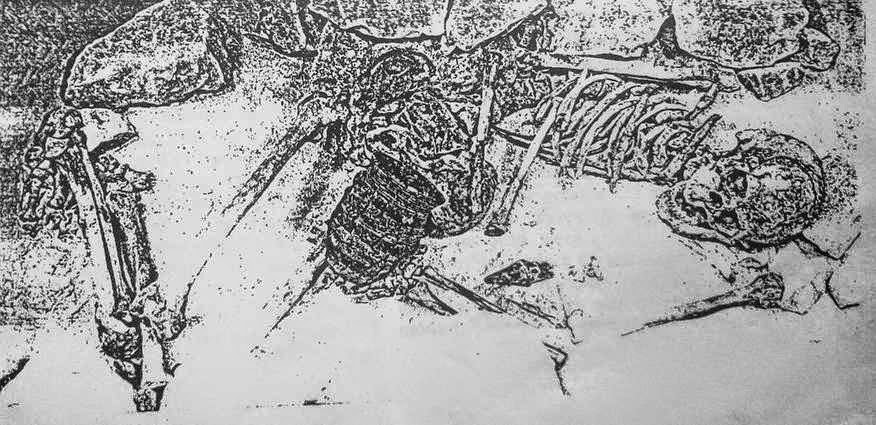History of Britain, Romans on the March. Caesar's departure in 54 BC might have been the end of Roman military interest in Britain. For the next ninety-seven years, there was peaceful trading between the tribesmen and the merchants from Rome.
By AD 43, homever, the Belgae - under King Cunobelinus whose capital was at Colchester - were carrying out raids on the French coast. Claudius, the Roman Emperor, became angry. Britain would have to be occupied. Claudius ordered his legions to march.
At about this time, Cunobelinus died. His realm was split in two. One of his sons, Togodumnus, ruled half of it; another, Caractus, the rest.
Caesar's invasions had been journeys into the uknown. Since then, homever, merchants had taken their products to settlements on the Humber, the Severn and the Trent. On their return, they were able to make useful reports about the geography army might encounter. One encouraging fact was that the Belgic tribes were disliked by their neighbours on either side, so much that they could expect no help in battle.
The Roman Army handed at Richborough in Kent. Togodumnus was killed early on in the fighting. Caractacus made a brave stand on the banks of the River Medway, but the opposition was too strong. At the day's end, he was fleeing for his life. The Roman march into Britain spread out to the four points of the compass.
West
Caractacus fled to Wales. For the next eight years, he was able to harass the Romans by making sudden attacks on their garrisons and lines of communication. Eventually, he and his family were captured, probably somewhere near Mount Snowdon. He was taken to Rome in chains, but Claudius admired his caurage so much that he spared his life.
On the far side of the Menai Strait, Anglesey was in the hands of the Celtic priests, the Druids. The Romans had heard they carried out human sacrifices. It was not to be tolerated. They crossed the water in boats; the cavalry's horses swarm. The engagement on the other side was brief and extremely bloody. When the fighting stopped, many of the Druids lay dead on their own altars.
South
To the west of the Roman landing place in Kent, the country was occupied by a tribe named the Regnenses. The king of the Regnenses was Cogidubnus; his capital at Noviomagnus (now Chichester).
Cogidubnus did not want trouble. Indeed, he was so helpful the Claudius gave him more land; confirmed him as a king and appointed him one of his representatives in Britain. Cogidubnus did so well out of it, that he was able to build himself a magnificent palace.
East
The king of the Iceni in East Anglia was also co-operative. When he died in AD 60, his will stipulated that Nero (who had become Emperor in AD 54, when Claudius was poisoned by his wife Agrippina) should share his estate with his widow, Boadicea (Boudicca), and their children.
Boadicea dutifully sent Nero his share of the bequest but the Emperor now insisted that he must have all the dead man's property. A Contingent of infantry was mustered at Colchester. Some while later, the men arrived at Boadicea's home near Norwich.
It was a dirty business. The palace was looted, the queen's daughters were assaulted, and she was whipped. Nero was no doubt satisfied, but he had lost the Iceni's loyalty for ever.
Gathering support from other tribes, Boadicea declared war on the Romans. But, the matter how brave they might be, her warriors were no match for the well drilfed legions of Rome. After minor successes, they angry queen fought her last battle on the edge of London (somewhere near the site of King's Cross station). At the cost of 400 casualties, the Romans killed 30,000 of her men. Boadicea escaped and hurried back to Norfolk, where she took poison.
North
In Ad 84, a Roman expedition marched into the Highlands of Scotland. On a hill known as Mount Graupius, in the region of Inverness, the legionaries met a force of tall men (most of whom seemed to have red hair) armed with long swords and circular shields. The Romans won, but this was far from the end of the matter.
 |
Hadrian: the Roman emperor with talent
for building walls. This larger-than-life
statue was dredged up from the Thames. |
Some years later, the 9th Legion was wiped out while marching to Tayside. Unwilling to lose any more troops, the Romans withdrew to England. In AD 121, Hadrian's Wall, (named after the reigning Emperor) was built. Seventy miles long, it stretched from the North Sea to the Solway Firth.
There were small forts at one-mile intervals, ditches, castles, camps and signal towers. Apart from sending an occasional patrol out into the Lowlands, the Romans kept to the English side of it. Scotland was left alone.
In AD 367, the wall was overwhelmed by the Picts who inhabited Scotland. They came back in 383 - only to find that all the garrisons had been removed. The Romans now had other things to worry about.
While the Picts were harrying them in the north, parties of Scots (from Ireland), Saxons and Gauls from France were making raids on the English coast. But the Roman occupation was nearing its end. In 406, the legions were withdrawn from Britain. Rome itself was now under attack and they were badly needed for its defence. Read previous :
The Roman Conquest, or read the next article :
Life in Roman Britain






















